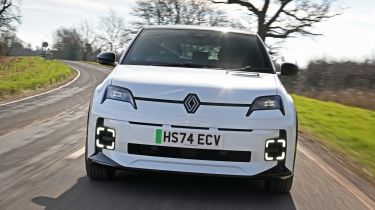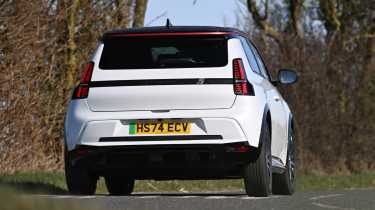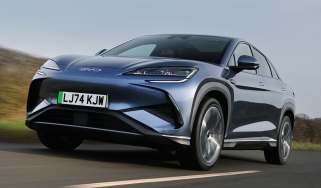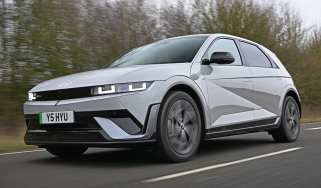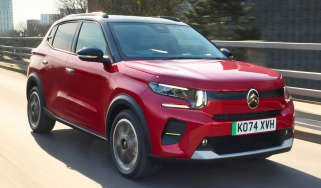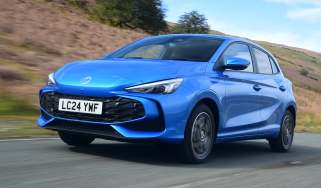Renault 5 review - Electric motor, drive & performance
“The Renault 5 handles brilliantly – it’s just a shame the limited power on offer can’t exploit its full potential”
The Renault 5 gets a choice of powertrains, with a 118bhp electric motor for entry-level versions and a more potent 148bhp motor also available. The focus here isn’t out-and-out performance, but the 5 does feel fun to drive at speed.
The front end gets suspension borrowed from the Clio and Captur – the former of which is good to drive in its own light – and as a result the suspension feels well tuned to the Renault 5. There’s very little body roll and the suspension feels composed, but the trade off is that the ride is quite firm, though it’s still much more comfortable than that of the MINI Cooper on rough roads. The steering is direct, and it’s also similar to the latest Megane – another electric model we think is great to drive. The feel through the brake pedal is at least quite natural, so the transition between regenerative and mechanical braking is almost imperceptible.
We’re not the biggest fans of Renault’s new approach to putting the gear selector on a stalk on the steering wheel – there’s just too much going on here and we even managed to accidentally flick on the windscreen wipers during low speed manoeuvres given how close this stalk is to the others. It’s also frustrating that changing drive modes is done via a button that you have to cycle through one-by-one to get to your desired choice, rather than a rotary dial or toggle switch, but at least this is on a dedicated button and not buried in the infotainment.
More reviews
In-depth reviews
We found the Eco mode to be rather redundant – it hardly increased the overall range and just made the throttle response very lethargic, so we’d give it a miss. Comfort’s standard setup feels natural and smooth, while Sport feels much sharper – so much so that in the cold, damp conditions we drove in, flooring it made the tyres scramble for grip. The Renault 5’s stability control system cuts in quite quickly while you’re driving it, though. This no doubt improves safety, but it also feels like some of the 5’s playful energy is held back by the tech.
Is the Renault 5 good to drive in town?
The original Renault 5 was designed to be a good supermini for urban environments and the new model should fulfil that brief, too. Its small proportions and nimble character make it easy to manoeuvre and park in town. From launch there’s no one-pedal driving, but this will be added to models later down the line – this can make urban driving incredibly easy, though it’s not for everyone. At lower speeds braking can be hard to do smoothly, which can make driving in urban areas less relaxed than you might want it to be. Overall, though, with its light, darty steering and tight turning circle, the Renault 5 feels well suited to urban driving.
Is the Renault 5 good to drive on long journeys?
One thing we weren’t expecting of the Renault 5 was for it to be such a reassuring motorway cruiser. Despite its impressive feel around town, it transforms into a sturdy, solid car on longer journeys because it feels so refined and quiet. Performance isn’t the quickest, but there’s enough oomph there to overtake and push on when needed.
Is the Renault 5 good to drive on B-roads?
The Renault 5 is one of the best-handling small cars on sale, but we think it’s a shame it’s not got more power. It’s incredibly agile and nimble and also feels well composed in the corners thanks to its low kerb weight. We just wish it was more powerful to make the most of these impressive traits, but thankfully a hot Alpine A290 version fulfills that brief.
| Model | Power | 0-62mph | Top speed |
| Renault 5 E-Tech (40kWh battery) | 118bhp | 9 seconds | 93 |
| Renault 5 E-Tech (52kWh battery) | 148bhp | 7.9 seconds | 93mph |
Carbuyer notes
“Renault has engineered a feeling of solidity into the way that the 5 behaves on the road. In terms of refinement and stability, it really doesn’t feel like a small car at all. It’s all very grown up and reassuring.” Alex Ingram, chief reviewer
Which Is Best?
Cheapest
- Name90kW Evolution Urban Range 40 kWh 5dr Auto
- Gearbox typeAuto
- RRP£22,285
Most Economical
- Name110kW Techno Comfort Range 52 kWh 5dr Auto
- Gearbox typeAuto
- RRP£26,285
Fastest
- Name110kW Techno Comfort Range 52 kWh 5dr Auto
- Gearbox typeAuto
- RRP£26,285
